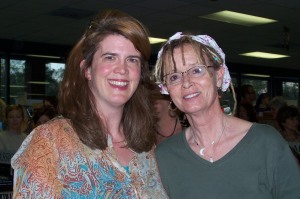We are thrilled to feature a guest post by Peggy O’Mara, mother, author, editor and owner of Mothering magazine. Here, she explores the foundations and history of Attachment Parenting, showing how AP became what it is today.
What is Attachment Parenting?
by Peggy O’Mara

The recent furor in the press over attachment parenting stems from an inherent misunderstanding. Attachment parenting is not permissive parenting. It is not about abdicating authority as a parent, but about responding to the legitimate biological needs of a baby. It is firmly based in the sciences of anthropology and psychology and specifically on the theory of attachment.
THE THEORY OF ATTACHMENT
The theory of attachment originated with psychoanalyst John Bowlby (1907-1990) whose influential 1951 report to the World Health Organization set the first standard for infant and child care:
“The infant and young child should experience a warm, intimate and continuous relationship with his mother (or permanent mother substitute) in which both find satisfaction and enjoyment.”
Bowlby and others identified the first three years of life as a critical period during which the foundation is set for attachment to self and others. Qualities secured during this period include: trust, empathy, dependency, affection, conscience and optimism. According to Maggie Scharf in Unfinished Business (Ballantine: 1981)
“The ancients well knew that the experience of being in love recapitulates the mother-child relationship in its intimate physical attachment, trust and dependency. It has been shown even in the animal realm that adequate sexual functioning in adulthood depends on satisfactory relations with the mother in infancy.”
LOOKING FOR SCIENTIFIC SUPPORT
When breastfeeding rates doubled between 1972 and 1982, mothers were looking for ways to reconcile the needs of their babies with the popular wisdom of the day. Breastfeeding moms were finding, for example, that their babies wanted to be held a lot while popular wisdom warned that holding was spoiling. Attachment theory reassured these early breastfeeding pioneers that touching and holding were good for babies.
John Bowlby, for example, observed during WWI that babies in orphanages died if they were neither touched or talked to.
Eric Ericksen identified the first year of life as a stage during which we learn to have faith in other people and in the environment. During this time of total dependency, if we receive adequate physical care that is warm, loving and demonstrative, we will learn to trust. On the other hand, if our care is cold, indifferent and rejecting we will learn to mistrust.
Margaret Mead, whose seminal book Coming of Age in Samoa (1928) informed the sexual revolution, observed in her field studies as an anthropologist that the most violent tribes were those that withheld touch in infancy.
Bowlby’s colleague, Mary Ainsworth, was a medical researcher who observed that the indulgence of early dependency needs leads to independence and self-reliance. According to Ainsworth, it is the sensitive responsiveness of the mother that enables the child to explore the environment.
Adult social behavior is related to early experiences in significant ways, according to neurologist Richard Restak. Restak says:
“Physical holding and carrying of the infant turns out to be the most important factor responsible for the infant’s normal mental and social development”
THE CONTINUUM CONCEPT
Further evidence that touch is good for babies came in 1975, from Jean Leidloff’s book The Continuum Concept. In the international best seller, Leidloff describes her expedition to the South American jungle, where she observed the way of life of indigenous natives.
She noticed, for example, that the mothers maintain nearly 24-hour-a-day bodily contact with their young infants, as they go about their daily tasks. Leidloff also observed that the native children are unusually self-possessed and secure and concluded that close physical contact in infancy is beneficial.
DR. BILL SEARS
While doing research for his book The Fussy Baby, Bill Sears, MD, discovered that the more babies were carried, the less they cried. He also found that carrying babies eases breastfeeding and high-need situations.
Sears tells the story of how his wife, Martha, instinctively tried to fashion a baby carrier from a piece of cloth in order to soothe one of their babies. Sears went on to design a baby carrier of his own, The Original Baby Sling.
In response to concerns that holding your baby can lead to an overly dependent child, Sears says that it’s the opposite:
“On the contrary, in our experience and that of others, carried babies actually turn out to be more secure and more independent. Because they have grown through early infancy with a secure home base, these children learn to separate more easily than others and with little separation anxiety.”
ATTACHMENT PARENTING, INTERNATIONAL
Sears published his book, The Fussy Baby, with La Leche League (LLL) in 1985, at a time when he was the most well known of LLL’s physician supporters. He is widely credited with coining the term attachment parenting and wrote a book on the subject in 2001. But, Dr. Sears did not invent attachment parenting.
Two young La Leche League Leaders, Barbara Nicholson and Lysa Parker, were influenced by Dr. Sears and fascinated with attachment theory. In 1987, they heard psychiatrist Elliott T. Barker give a keynote address on “The Critical Importance of Mothering” in which he linked adult psychopathic behavior to extreme disruptions in attachment.
As Nicholson and Parker became increasingly steeped in research on the critical attachment period, they wanted to educate others, and, in 1995 they formed Attachment Parenting International (API).
API’s “principal goal is to heighten global awareness of the profound significance of secure attachment” through education, support and advocacy.
Breastfeeding, co-sleeping, and baby wearing all foster secure attachment because they respond to the baby’s need to be touched and held.
But these are not the practices of attachment parenting and attachment parenting itself is not a practice. It is a philosophy.
There are no rules to Attachment Parenting. It’s simply about acknowledging the legitimate needs of the human baby and trying to meet them as best one can.
JUST INFORMATION
While the roots of attachment parenting are in ancient tribal society and modern science, attachment parenting has no script. It’s about trusting the baby and being responsive. It’s practical and personal. It’s not a contest. It’s just information.
 Peggy O’Mara founded Mothering.com in 1995 and is currently its editor-in chief. She was the editor and publisher of Mothering Magazine from 1980 to 2011. The author of Having a Baby Naturally; Natural Family Living; The Way Back Home; and A Quiet Place, Peggy has lectured and conducted workshops at Omega Institute, Esalen, La Leche League International, and Bioneers. She is the mother of four.
Peggy O’Mara founded Mothering.com in 1995 and is currently its editor-in chief. She was the editor and publisher of Mothering Magazine from 1980 to 2011. The author of Having a Baby Naturally; Natural Family Living; The Way Back Home; and A Quiet Place, Peggy has lectured and conducted workshops at Omega Institute, Esalen, La Leche League International, and Bioneers. She is the mother of four.









 The Fall 2012 issue of
The Fall 2012 issue of